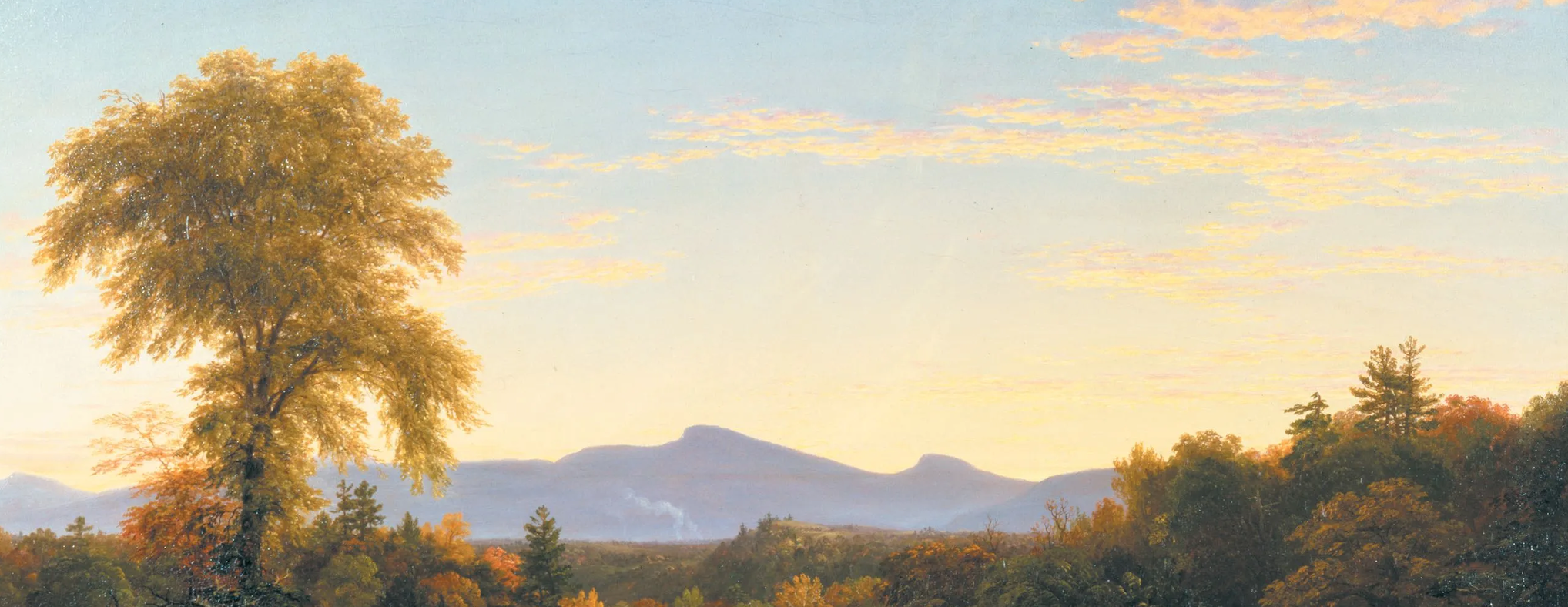I rummage in my waist pack for a sound recorder and microphone, the zipper and fabric sounding obnoxiously loud, then I hold still, pointing the microphone toward the tip of the ponderosa pine tree where the bird perches. For a few minutes, I rest in the presence of the song.
Then a hiss and a bellow. The wind gusts from the northeast, passing unobstructed across the wide valley between mountains. The trees’ sounds reveal the inner life of the air. Ropes of forceful flow draw roaring surges from the canopy, bands of sound that snake and leap. Eddies punch down from air into the trees, then dissipate. Pools of quiet move through this tumult like blown leaves on a lake surface, skimming, pausing, then veering in new directions. The volume indicator on my sound recorder lurches into the red, and I twist down the gain knob. Suddenly the forest is shouting.
But the bird keeps singing, somehow penetrating the fog of noise. The song’s fine brushwork stands out, strokes of luminous pigment against the gray wash of wind.
The character of the mountain is contained within this song. When this male red crossbill offers his springtime melodies, the combined experience of thousands of ancestors flows to the air. Only those predecessors whose songs accommodated the particular challenges of the wind in these trees passed on their genes. Evolution shaped the song to the place.
Red crossbills live always among evergreen trees, wandering in search of seed‑filled cones of pine, spruce, Douglas fir, and hemlocks. Their relationship with these trees is so long‑standing that evolution has carved the birds’ beaks to fit conifer cones. The tips of the stout, hooked beaks cross, the sharp point of the lower mandible twisted to one side and the end of the upper mandible curving the other. The birds slide these beak tips between cone scales and, with a sideways slide of the lower mandible and a turn of the head, pop the cones apart, giving their long tongues access to the seed hidden at the base of the scales.
The birds’ love of conifers has marked their songs too. These trees are vociferous when stirred by the wind, roaring even in modest gusts. And except in the calmer days of summer, the wind is a frequent presence. A map of North American average wind speeds at ten meters above the ground, the height of tall trees, shows a band of strong winds running down the spine of the Rocky Mountains. Houses here shake under its power for days. Trail walking often feels like wrestling with an inexhaustible adversary, especially in the season of strong winds in late winter and spring when crossbills are singing. In Europe and eastern North America, the closest comparison is the uncompromising force of a gale rising from a sea cliff: exhilarating to walk in at first, then draining.
My body feels out of place, but the trees are at home. Their springy branches accommodate the flow, flexing and shedding the wind’s power. Unlike lowland pine trees, needles of upland conifers are like wires or spikes, toughened to resist the fraying, tearing action of the wind. An oak or maple here would have its branches snapped and leaves shredded. The tough needles and flexible branches of the mountain conifers produce wind‑evoked noise unique to these forests, a sound that has likely shaped the crossbills’ song. From wind, to trees, to birdsong.
Later, I pull up the sound recording on my laptop. A graph scrolls as the sound plays, showing how the sound frequencies change through time. Fine lines scribbled on a clear background reveal the structure of the crossbill’s phrases. Tee‑tup‑tup, a sharp upward exclamation, then two shorter notes. He throws in a lower, raspy bree‑bree. After a minute, he delivers a string of shorter, sweeter tup notes, ending with a very high see. Then galloping variants, in clusters of three or four. Chik‑a‑eee pops in, a snatch of song very similar to that of the mountain chickadee. In all, the song has a dozen elements and the bird seems to remix them as it goes, grouping, rearranging, and adding little flourishes and inflections. The result is sprightly and nimble, full of bright motion.
Leaves, stems, and tree trunks absorb and reflect sound, muffling and adding reverberation.Suddenly a smear darkens the screen. The wind has arrived. The bottom half of the graph, the zone showing the lower frequencies, is fogged with the sound of the trees. The crossbill’s song dances over this cloud. The bird’s notes are all higher‑pitched than the great whoosh of the pines and Douglas‑firs.
When wind hits these forests, the resulting sound is almost all below one or two kilohertz. This is quite different from the sound of wind in other forests. When strong gusts hit oaks and maples, or pass through the canopy of the tropical forest, they evoke hissing noises that extend to much higher frequencies, five or six kilohertz. In the mountains, then, wind is a low roar that can last for hours or days. But in most other forests the wind is less frequent, and when it does come, it is high and sibilant. There’s a human quality to the voice of these conifers. In them, the wind produces sounds in the frequency range of human speech, unlike the higher sighs and rustles of other tree species.
The red crossbill’s song is higher than we would expect for an animal its size. Like musical instruments, the pitch of an animal’s song is usually a product of its size. Ravens croak low, hummingbirds squeak high. But the red crossbill bends this rule, singing higher than other species of its size.
The forests are present in the red crossbills’ songs not only in their relation to the wind but in the effects that tree cones have on the evolution of crossbill beaks. Red crossbills of the Rocky Mountains have stout beaks, suited to ponderosa and lodgepole pine. In the Pacific Northwest, birds of the same species have smaller beaks, adapted for opening Sitka spruce and western hemlock cones. Small beaks, by virtue of their nimbleness, can sing fast, with high‑pitched trills. The variants of the songs of the red crossbill and its slimmer‑beaked cousin, the white‑winged crossbill, therefore, are partly shaped by the diversity of cone shapes among local trees.
It is not just crossbills that are high‑pitched in the coniferous mountains.
In the autumn, elk fill the mountain valleys with mating calls that carry for kilometers as they echo from slopes and cliffs. Zoologists call the elk’s song bugling, but its timbre is more like a flute hitting weird harmonics. The elk tips back its head and releases a nearly pure tone that slides up, holds steady for a second or two, then slips down, often edged with rough grunts. The first time I heard the sound, in a spruce forest in the Rocky Mountains, I could not believe that such a high sound could come from so massive an animal. A bull elk weighs more than three hundred kilograms. The steady central note of the elk’s bugle is between one and two thousand hertz, a little higher than the squeak of a rabbit.
Human speech and hearing reveal our nature as a large mammal of open grassland and savannah.The closely related red deer of northern Europe makes a much deeper sound, two hundred hertz, a throaty roar at the frequency we would expect from an animal this size. Studies of vocal folds taken from hunter‑killed carcasses have yet to resolve the mystery of how elk make their sounds. As expected for a large animal, their vocal folds are long, three times as long as ours, yet they force a high‑pitched sound from this large instrument. Their throat bones and ligaments are shorter than those of red deer, though, suggesting that they may clamp or otherwise constrain part of their vocal folds, shortening them so that they can vibrate fast enough to make the extraordinary song.
In the autumn rutting season, male elk sometimes lunge at each other and butt heads in a clatter of antlers. But most of their jousting is at a distance, through sound. I’ve sat on mountain slopes above the tree line and heard males calling back and forth from a distance of five kilometers. Only airplane noise travels farther in the high country. Males usually call from open meadows along meandering streams or from the adjoining coniferous forests. To be effective, bugling calls have to travel hundreds of meters through conifers. Males are signaling to one another, but also to the female elk who live year‑round in matrilineal herds. These close‑knit groups gather in the autumn in mountain valleys, where rutting males compete for the privilege of attaching themselves to each herd. These aggregations are often completely out of sight of one another, but linked by bugling sounds from the males.
Just as the crossbill’s song seems well matched to the particular sound of Rocky Mountain forests, so does the bugle of the elk. A bellowing, low call would be smothered by the wind. This is an unusual situation. In most habitats, low sounds are more effective than high sounds for long‑distance communication because low, long‑wavelength sounds flow around obstacles and are less degraded than high sounds by wind turbulence. But in coniferous forests with strong, persistent wind and stiff‑needled trees, the masking noise of trees seems to override these advantages, pushing animal signals into higher frequencies.
Two examples from the mountains do not prove that environmental noise has shaped the voices of the animals here. The high voices of the crossbill and elk might have their origin in sexual competition and choice, sonic versions of colored plumes and exaggerated antlers. Or the ears of both species may be especially sensitive in the high registers, tuned to informative sounds from predators, competitors, and kin that are not masked by the roar of wind. Such a fit of hearing to habitat would then favor social communication at these higher frequencies. These hypotheses are, without more information about the history and society of each species, impossible to disentangle.
Every time I visit these mountains, though, I am struck that forests with the loudest trees I have ever encountered are inhabited by animals whose voices are unusually high, leaping over the roar. A wider survey of animal vocal communication reveals the effects of the physical environment on sound. Birds living on rocky coasts have cries loud and strident enough to be heard through the tumult of waves and the shearing action of wind. Gulls, oystercatchers, and shorebirds avoid soft murmurs or subtle inflections. Instead, they slice through the wind noise and the sound of pounding waves with emphatic strokes. Birds and frogs that live near rushing waterways vocalize with loud and high‑frequency calls, vaulting over the masking rush of water.
Form, vivid, fulvous, favorite: in the sound of these English words we hear how domesticated foods have shaped our mouths and thus our language.In forests, vegetation attenuates and degrades animal voices. Leaves, stems, and tree trunks absorb and reflect sound, muffling and adding reverberation. At a distance, every note is hushed and blurred. Most forest birds therefore sing with slower, simpler whistles and slurs than their cousins of open country. The North American scarlet tanager’s rich up‑and‑down warble, chirru‑cheery‑chirru‑cheery, for example, is well suited to breeding territories thick with maple, oak, and hickory leaves, as are the singsong notes and inflected fluting of many Eurasian thrushes, Australasian whistlers, and songbirds of dense tropical forests worldwide.
In contrast, on the open prairies and plains, it is not vegetation that degrades sounds but wind shear and turbulence. Here, subtle inflections of pitch are erased by the wind. Many birds of grasslands and open rocky areas therefore buzz and trill, delivering repeated staccato notes that cut through the wind. The trilling songs of the dusky grasswren in Australia, grasshopper sparrow of North American grasslands, and calandra lark of the Mediterranean and western Asia are all examples of whirring, rapid notes among birds of open country.
Unlike birds, mammals living in dense vegetation have higher voices than those from open country. This seems to be caused by differences in hearing. A survey of fifty species found that the average peak of hearing sensitivity for forest‑dwelling mammals was nine and a half thousand kilohertz, three thousand kilohertz higher than that for species that live in the open. This difference is likely caused by the pressing need to hear quiet, high rustles and the soft whish of other animals brushing against leaves. With no wings with which to make rapid escape or arrival, forest‑dwelling mammalian prey and predators rely on their ears to hear approaching danger and opportunity. These sounds of animal movement in vegetation are mostly high frequency, favoring animals with ears tuned to this range.
This, in turn, favors high‑pitched communicative sounds, hitting the most receptive spot in the ears of mates and competitors. The sounds of forest mammals therefore tend to be higher than those of their cousins of the plains and savannahs. The growls, chirrups, and meows of cats that live in forests, such as the Asian golden cat or the lynx, for example, are pitched higher relative to body size than the vocalizations of open country cats like the caracal of Africa and Asia or the manul of Asia. The same is true for the barks, chips, and chatters of forest‑dwelling tree squirrels and chipmunks compared with their kin, the ground squirrels and other rodents of open meadows and deserts.
Our voices are therefore ill suited to long‑distance communication in forests. Words are swiftly muddied.Human speech and hearing reveal our nature as a large mammal of open grassland and savannah. The peak of our hearing sensitivity falls between two and four kilohertz, and our speech is low, from eighty to five hundred hertz, spiced with sibilant sounds that reach up to five kilohertz or more. The peak of hearing sensitivity of our closest relatives, chimpanzees, is eight kilohertz, and they hear much higher sounds than we can, up to nearly thirty kilohertz.
Chimpanzees have a diverse vocal repertoire, much of it high. Their long‑distance call, the pant hoot, starts with quiet low grunts then climaxes with a scream akin to a piercing squeal from a human child, given at fifteen hundred hertz, much higher than an adult human scream, about four hundred hertz. Any pairwise comparison like this can be confounded by differences in body size—we’re a little heavier than chimpanzees—and the quirks of each species’ ecology. But in this case, the differences between humans and our chimpanzee relatives accord with the trends measured across broad surveys of hearing and vocalization in mammals.
Our voices are therefore ill suited to long‑distance communication in forests. Words are swiftly muddied. Instead, human cultures that seek to connect through the forest use loud drums or whistles. There are dozens of whistled languages around the world, and most come from areas with dense forests. Whistles not only carry well through vegetation but, with practice, can be much louder than any human vocal sound, carrying messages for a kilometer or more.
Diet has also shaped the diversity of animal sounds. Birds with large beaks tend to sing slower songs, with narrower frequency ranges, because large beaks impose a physical constraint on sound making. This trend is especially evident in the woodcreepers, birds of Central and South American tropical forests. Beaks within the woodcreeper family range from stubby on the spot‑throated woodcreeper to astonishingly pole‑like on the long‑billed woodcreeper. The longer the beak, the slower and narrower in frequency is the song: trills in the short‑beaked species and drawn‑out whistles for those with elongate beaks. The many species of Darwin’s finches on the Galápagos Islands show similar patterns, as do different geographic variants of the red crossbill.
Diet seems to affect the acoustic form of human speech, as measured by comparisons across the six to seven thousand languages that we speak worldwide. The speech of hunter‑gatherers tends to lack labiodental sounds, the Fs and Vs made by pressing lips to teeth. These sounds are three times more common in the languages of agriculturalists, whose softer foods cause the dental overbite of childhood to persist into adulthood. In hunter‑gatherers and in our Paleolithic ancestors, the overbite disappears as teeth encounter tough foods and thus develop a strong edge‑to‑edge bite. Form, vivid, fulvous, favorite: in the sound of these English words we hear how domesticated foods have shaped our mouths and thus our language.
___________________________________

Excerpted from Sounds Wild and Broken: Sonic Marvels, Evolution’s Creativity, and the Crisis of Sensory Extinction by David George Haskell. © Copyright 2022. Available from Viking, a division of Penguin Random House.


